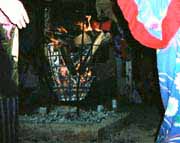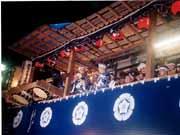Schedule, Program
Schedule
The schedule of Nishimonai Bon Dancing is a little bit later than that of normal Bon season, and it is danced 3 days during August 16 to 18 of solar calendar. The schedule can be considered that they chose a date that is rather close to the Bon season of lunar calendar. Also, it can be thought that there was a meaning in dancing after finishing the Okuribi.
Program
When the Yose-Daiko starts in the evening, dancers and the audience gather in groups, and soon the dance begins. There are two types of dances (“Ondo”, “Gonge”). The children dance “Ondo” in the early evening, and mainly grown-ups dance “Gonge” from late night. However, in these days they dance Ondo and Gonge mutually. Everyone gathers in front of Hayashi-kata and praise each other in the end.
Location of the dance
They dance at the main street in the center of the town. They build bonfires in each side of the street, make a big circle around the town, and dance and turn around. When you dance Bon Dancing in the light of bonfires in the old streets makes you feel like as if you went back to the days of Edo Era.
Facilities
Sajiki
During the dancing period, Sajikis are prepared for the audience in each side of the dancing venue which is located in the center of the street. One side is reserved seat, and the other is unreserved. The unreserved seat may be crowded. Also, the local people spread vinyl sheets on the roadside from early in the evening and watch the dance.
Bonfire
The dancing venue is partitioned by burning bonfire in each side of the street. The bonfire is considered to have a meaning as “Mukaebi” of Bon, and it can be observed that old customs before lanters remained by changing its shape.
Kodera Yuukichi mentions Nishimonai Bon Dancing as an example of “A dance surrounding bonfire” in his book “Researches on Bon Dancing”. According to this book, in Nishimonai, Bon Dancing starts after finishing Seirei-Okuri (Sending the spirits off), and they burn bonfires in many spots of the street, while the dancers turn around the bonfire and dance. According to this fact, Kodera points out that this has a meaning as “Okuri-bi”, and “Kiriko-Dourou and Kagaribi(bonfire) could be the same”
When you dance Bon Dancing with the light of bonfire in the street where old rows of houses remain, you can feel a taste that you went back to the old days of Edo Era.
In the pale light of the bonfire, the blackness of Hikosa-Zukin and the facsinating colors of Hanui-Ishou sets them off to advantage, and gives a magnificent effect.
Hayashi Yagura (Scaffold of musical accompaniment)
Hayashi Yagura is built in the side of the street, and Ondo Tori and Hayashi play music on it. Mizuhiki-maku of the family crest of Onoderera family “Itsutsu Mokou” is put up, and “Maru-jouchin (round lantern)” with family crest is hung. Also, Naga-Chouchin (long lantern) is hung with letters like “Gokoku Houjou (rich harvest)” “Hounen Mansaku (bumper harvest)”. The lower part of Yagura (scaffold) is decorated with Koshi-manmaku.
People
Since Nishimonai Bon Dancing is difficult to dance, the dancers are mostly local people and dance lovers. Among the dancers, you can see several age brackets by looking at the dancer’s costumes; small children (casual yukata), girl (kuroko-zukin), adult women (hanui-ishou). Also, sometimes you can see adult men wearing female dress. It seems to be that young men are rather few.
Hayashi and Ondo-toris on the Hayashi Yagura are important members besides dancers. Nishimonai Bon Dancing Conservation Society is playing an important role in conservation of the dance, and is teaching how to dance.



